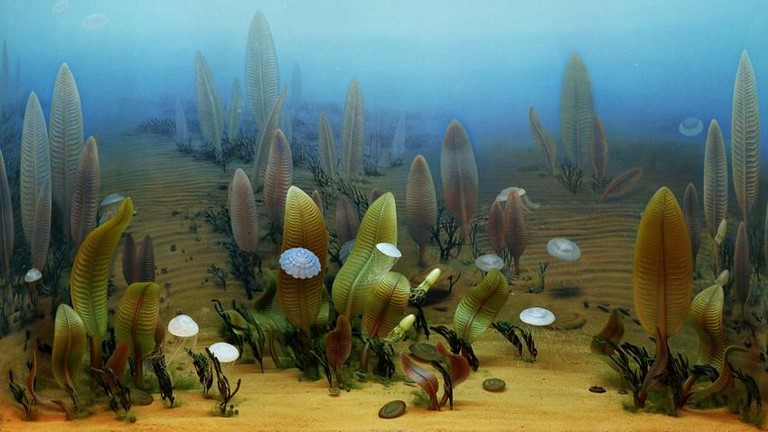Flight from light:Is Earth' magnetic field responsible for the Cambrian Explosion?

Biologists and paleontologists have long been heatedly discussing the Cambrian Explosion which occured some 542 million years ago. It seem to evidence, at least in the views of the first researchers who worked on it, a brusk increase in the number of multicellular species, especially animals, as well as in the complexity of living forms.
In order to explain this major event in the history of the biosphere, numerous hypotheses have been proposed, changing according to the state of our knowledge of evolution and of the history of Earth. The latest in date comes from geologist Joseph Meert, from Gainesville University in Florida. Together with his colleagues, the researcher exposed it in detail in an article published in Gondwana Research.
Here, the science of paleomagnetism has been put to contribution in the hope of piercing the mysteries of the Cambrian Explosion. While examining magnetic archives contained in sediments found in Russia, more precisely in the Ural Mountains, paleomagneticians have made a surprising discovery concerning magnetic reversals some 550 million years ago.
We have known since the XIX century that magnetic particles, behaving like small compasses and aligning themselves with the force lines of the terrestrial magnetic field, can preserve the traces of their local orientation in clays and in lava. At the beginning of the XX century, French researcher Bernard Brunhes discovered, by studying these rocks, that the Earth’ magnetic field could undergo reversals. It was later discovered that this has happened at numerous occasions.
Scrutinizing geological records, researchers have discovered that these reversals are not subjected to periodicity and that the passage from one polarity to the other is accompanied by a period during which the magnetic field of Earth is lessened. However, the magnetic shield protects Earth from the cosmic rays which can damage DNA and provoke mutations. There have been ongoing speculations about the impact of these events on the biosphere without firm conclusions being reached.
It remains that Joseph Meert and his colleagues have discovered that at the end of a period called Ediacara, in which there already existed forms of simple multicellular life resembling jelly-fish, the magnetic field of Earth reversed itself several times in a short lapse of time. Researchers estimate that these reversals occurred at a rate 20 faster on average than in the past million years. “Earth’s magnetic field underwent a period of hyperactive reversals,” Meert says. One can deduce from this that the magnetic field of Earth must have been weaker on average during several episodes over a period of several million years.
According to Meert, the cosmic rays bombardment occuring then would have been sufficient to significantly damage the ozone layer, reducing it by some 40 % on average all over the planet. And less ozone means decreased protection against ultraviolet rays for species living at the surface of Earth, on land and in the oceans. Curiously, these febrile reversals coincide with what palaeontologists are calling a biological crisis, in this case the crisis of the Kotlinian, which decimated the fauna of Ediacara wholesale, right before the Cambrian Explosion.
The Kotlinian Crisis, as it is known, saw widespread extinction and put an end to the Ediacaran Period. During this time, large (up to meter-sized) soft-bodied organisms, often shaped like discs or fronds, had lived on or in shallow horizontal burrows beneath thick mats of bacteria which, unlike today, coated the sea floor. The slimy mats acted as a barrier between the water above and the sediments below, preventing oxygen from reaching under the sea floor and making it largely uninhabitable.
The Ediacaran gave way to the Cambrian explosion, 542 million years ago: the rapid emergence of new species with complex body plans, hard parts for defense, and sophisticated eyes. Burrowing also became more common and varied, which broke down the once-widespread bacterial mats, allowing oxygen into the sea floor to form a newly hospitable space for living. (Ian Randall, Science).
So that researchers are now proposing that there exists a link between both events ; confronted with an increase in ultraviolets, animals adapted. “Organisms with the ability to escape UV radiation would be favored in such an environment.” This flight from dangerous levels of UV light might explain many of the evolutionary changes that occurred during the Late Ediacaran and Early Cambrian, Meert says.
Creatures with complex eyes to sense the light and the ability to seek shelter from the radiation—for example, by migrating into deeper waters during the daytime—would have been more successful. The growth of hard coatings and shells would afford additional UV protection, as would the capacity to burrow deeper into the sea floor.
In turn, these changes may have opened up new environments. The development of shells, for example, helps creatures colonize intertidal areas, protected not only from UV rays but also stronger waves and the risk of drying out. (Ian Randall, Science).
In a communiqué to Science, geobiologist Joseph Kirschvink raises some doubts about this hypothesis explaining that UV rays, if they promote mutations among unicellular organisms, have less effects on animals because these rays must create mutations in the DNA of reproductive cells which are less exposed, as they are situated inside the body. One may also think that the Cambrian Explosion is due to a multiplicity of factors, such as the increase of oxygen in the oceans.
Translated from the French by Anne-Marie de Grazia and adapted from an article by Laurent Sacco, in futura-sciences, 02/19/2016 with additions from an article by Ian Randall in Science.
Read also: Genesis and Extinction, by Alfred de Grazia


